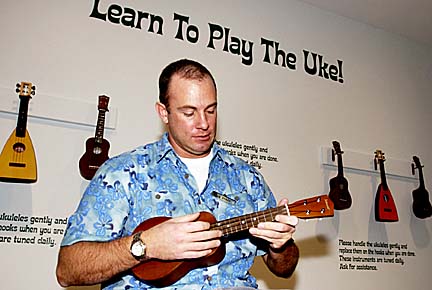


|
STAMFORD, Conn. >> The four-string instrument is tiny but tells a big story of America in the 20th century and even evokes fantasies of paradise. Ukulele exhibit tugs
at heartstringsThe Stamford Museum bills its display
as the first on the history of the instrumentBy John Christoffersen
Associated PressThe ukulele, long overshadowed by the guitar and keyboards in popular music, is finally getting its due.
The Stamford Museum and Nature Center is billing "Ukulele Fever: The Craze That Swept America" as the first exhibit on the history and social significance of the ukulele.
"It's the people's instrument," said Jim Beloff, who wrote a book on the ukulele and helped organize the show. "It's a wonderful instrument to be reconsidered now."
The exhibit, which runs through May 26, includes more than 100 ukuleles dating back nearly a century. The collection includes rare instruments, highly ornamented models, a ukulele owned by singer Tiny Tim, instruments made out of coconut shells and even beach ukuleles that reflected the groovy 1960s.

|
The museum is offering a workshop on how to learn to play the ukulele in 61 seconds. A film from the 1920s shows how the instrument was made, and an accompanying hands-on exhibit teaches children about Hawaii.The ukulele, which resembles a small guitar, originated in Portugal. It became a sensation in Hawaii when Portuguese immigrants arrived to work in the sugar cane fields.
Hawaii officials promoted the ukulele at an international exposition in San Francisco in 1915.
"Then the thing all of a sudden becomes a craze," said Sharon Blume, executive director of the Stamford museum.
Production of the instrument skyrocketed. Vaudeville and Hollywood embraced the ukulele, which became a major prop in many movies, including the films of Laurel and Hardy and later Marilyn Monroe, Lucille Ball and Bob Hope.
A second wave of popularity erupted after servicemen were sent to Hawaii during World War II.
Air travel after the war opened the enchanted islands to the masses.
The instrument's sweet, soft strumming sound evoked images of carefree living and happiness.
"Hawaii is, for many people, paradise on earth," Beloff noted.
Arthur Godfrey offered ukulele lessons on his popular television show in the 1950s, further enhancing the instrument's status.
"It became a great popular item, a must-have object," said Rosa Portell, the museum's curator.
Demand was natural: The instrument not only evoked images of enchanted islands that were new to Americans, but also was affordable and easy to play and transport.
"It took over at a particular time in the 20th century," Blume said. "People were starting to lose some of their conservatism. Here's this fun little instrument."
American companies recognized the appeal, using the ukulele to promote everything from travel to personal hygiene. The ukulele also underscored the growing importance in the 1950s of plastic, which allowed for the mass production of millions of instruments.
The ukulele has a knack for reflecting the times.
During the Depression, down-and-out artists painted and decorated some instruments. When World War II broke out, some ukuleles were painted red, white and blue and shaped like V's for victory, complete with eagles.
In the 1960s, ukuleles grew longer and brighter to reflect the groovy times. You could even stick them in the sand.
Guitars and keyboards dominated since the Beatles, but the ukulele is making another comeback, enthusiasts say.
The late George Harrison, best known for hits such as "While My Guitar Gently Weeps," loved the ukulele, according to Beloff, who once played with the Beatle.
Modern bands such as Pearl Jam have incorporated the ukulele.
Organizers of the exhibit expect 30,000 to 40,000 visitors from around the country. Those who have attended so far say the exhibit is sparking memories of older relatives who played the instrument.
"I hope it revives the visibility of the instrument," Beloff said. "The ukulele sort of resides in this never-never land."
www.stamfordmuseum.org